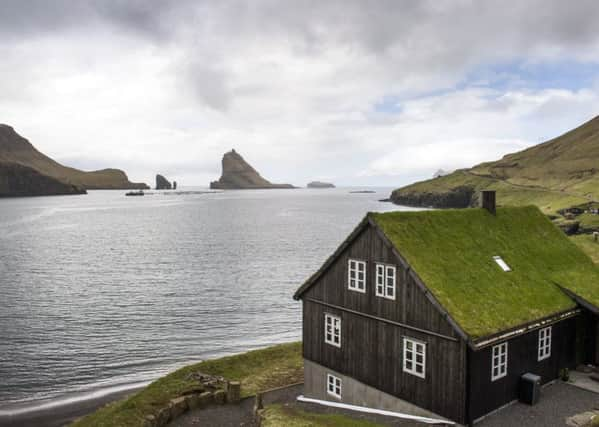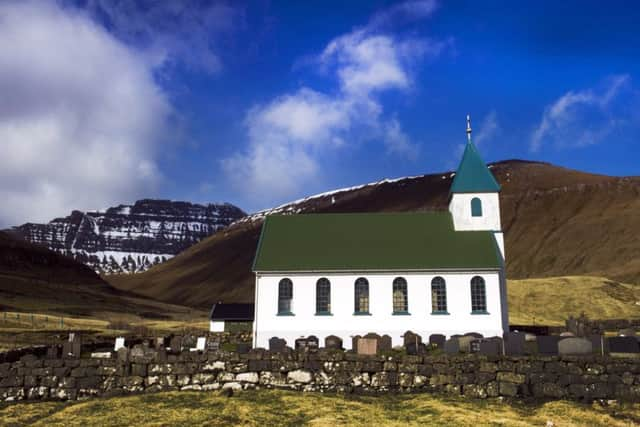Travel: The Faroe Islands


THE Faroe Islands are not your run-of-the-mill holiday destination. When I told my friends about my impending trip, the reaction was perhaps predictable: “Eh… Oh, lovely. Where are they exactly? Off Scotland… somewhere near the Falklands… in Africa? Didn’t we only just beat them in the Euro qualifiers?’
In fact this obscure collection of 18 islands, all but one of which are inhabited, lies about halfway between Iceland and Norway in a lonely corner of the North Atlantic, 180 miles north of Shetland. Since 1948, the Faroe Islands have been a self-governing region of Denmark, but it was Irish monks, not Vikings, who are thought to have been the first settlers. For generations, Faroese have shared the story of St Brendan, an Irish abbot said to have sailed from Scotland to the islands between the years 512 and 530. Brendan was searching for “the promised land of the saints” when he encountered “the islands of the sheep and the paradise of the birds”.
Advertisement
Hide AdAdvertisement
Hide AdDespite the remoteness, the islands are easy to reach. The Faroese flag carrier, Atlantic Airways, launched a new twice-weekly scheduled service this spring direct from Edinburgh, part of a new strategy of focusing on more frequent links to the island’s closest neighbours.


During the flight we saw nothing for 60 minutes and then, magically out of nowhere appeared a series of mountains, like dinosaurs shouldering out of the sea.
The land looks like the west coast of Scotland, all craggy cliffs and frilly coastlines – and is staggeringly beautiful. The weather, like ours, is changeable and waterproofs are an all-year fashion. The Faroese live close to nature, mainly the sea. There’s a small church in every village and 95 per cent of the islands’ income comes from fishing and related industries.
The journey from the airport provided us with our initial taste of the unyielding landscape. We first visited the delightful, sleepy fishing villages of Bour and Gásadalur, complete with low, turf-roof buildings painted in bright primary colours. The latter was connected to the rest of the island by a tunnel in 2006 at a cost of about £1m per inhabitant. Before this you had to climb over a 600m mountain to get in or out and no-one can have envied the postman who did it two or three times a week.
To experience authentic Faroese life – and architecture – we stayed at the Gjáargardur Hotel, a wooden, sod-roof guesthouse in the tiny village of Gjógv. The village is situated at the very tip of Eysturoy island, with a cluster of brightly painted houses snuggled at the foot of formidable mountains facing out towards the sea with nothing between them and the North Pole except the occasional broaching whale. Gjógv was the ideal place for a taste of rugged, remote beauty.
For the remainder of our visit we headed to Tórshavn. With only 19,000 inhabitants, it is the smallest capital in the world, but feels like a metropolis compared with the islands’ other settlements which largely rely on fishing for sustenance and, occasionally, a traditional, now controversial, annual pilot whale hunt. Here, we stayed at the Hotel Foroyar, one of the islands’ most comfortable hotels, with minimalist Nordic design inside and out and a traditional grass roof complete with cod hanging from the eaves to dry, spinning in the wind. The hotel is also home to Koks, one of Scandinavia’s finest restaurants. A pioneer of new Nordic cuisine, it offers an unmissable crash course in the culinary practices and delicacies of the Faroe Islands, all served with a panoramic view of Tórshavn.
The menu showcases locally sourced ingredients such as seaweed, dried fish, lamb’s heart, sea urchin and horse mussel. I opted for the 20-course tasting menu, but lost count by the time a team of waiters arrived with something that looked like ostrich eggs. In unison they opened the porcelain “eggs”, releasing the smell of burning pine, and inside was the most perfectly smoked piece of langoustine – it had left the pristine waters just a couple of hours previously.
To work off the excesses of the meal, we hiked over the hills to Kirkjubøur and enjoyed views across to Koltur island, which looks like it would make a good Bond villain’s lair. On the way back to Tórshavn we pass the remains of St Magnus’s Cathedral by Roykstovan, a red and black house said to be the oldest wooden dwelling in Europe, perhaps the world, and home to Joannes Patursson, whose family have farmed here for 17 generations. Joannes shared his views on everything from Faroese independence to the idiosyncrasies of the feudal-sounding system of state land ownership, including one peculiar state law that stipulates every farm must have three milking cows and at least 323-and-a-thirteenth sheep, otherwise the government imposes a fine.
Advertisement
Hide AdAdvertisement
Hide AdTórshavn is surprisingly quirky, with a distinct sense of style, and is the best place to pick up a Faroese original; a traditional hand-knit Gudrun & Gudrun star-pattern sweater. The company’s most famous jumper was a worldwide hit when detective Sarah Lund wore it in the Danish series The Killing. Since no dyes are used, the classic sweaters reflect the natural colours of the local fluffy Faroese sheep dotted everywhere, roaming freely around the islands. The Danish name thus translates as “the islands of sheep”.
On our last day we took a helicopter tour of the more isolated islands. The most distinct is Tindhólmur, a 262m-high, uninhabited islet near the island of Vágar. This archipelago was formed around 55 million years ago when Greenland and Europe separated and a large basaltic formation known as the Faroe-Rockall Plateau came into being. The best way to describe the resulting volcanic formation, would be as giant slices of tiered basalt. Or in case of Tindhólmur, as a giant shark tooth.
From the air you can truly appreciate the forces of nature and why the vagaries of the climate mean everything to the people who live there. At some point, it dawns on you that there are no trees, no woods to get lost in, nothing to block your sight. It’s the kind of place that makes you realise the earth is so much bigger than you ever imagined.
FACT FILE
• Atlantic Airways’ twice-weekly flights to the Faroes have been extended to continue until 18 December, with an additional service on 4 January, 2016, before the full service resumes on 18 March, 2016.
• The scheduled service operates from Edinburgh on Friday mornings and Monday evenings, with return flights on the same days. Fares to the islands start at just over £200, including taxes, charges and fees, booked online (exact fare subject to exchange rates).
• Gjáargardur Hotel, Gjógv, Eysturoy island, B&B rooms start from DKK845 (£81) (summer season, 1 May to 30 September), (www.gjaargardur.fo)
• Hotel Foroyar, Tórshavn, single rooms start from DKK1,500,00 (£143) (www.hotelforoyar.com)
• Gudrun & Gudrun Knitwear, Tórshavn (www.gudrungudrun.com)